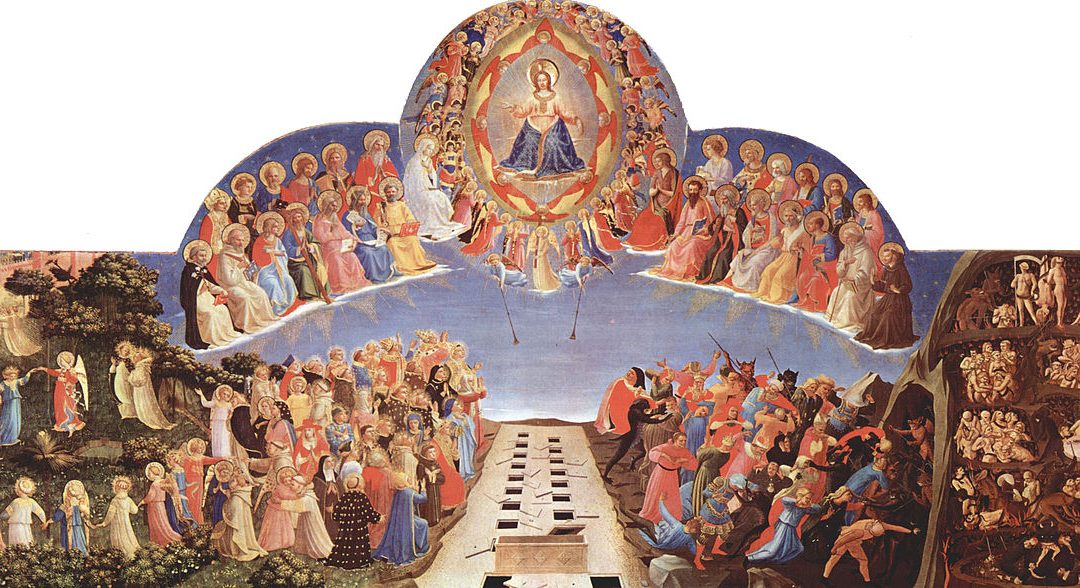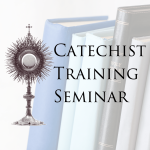This article is part two of a four part series. The previous article in this series can be found here.
As we mentioned in part one of this series on the novissima, or the four last things, we are all created to know, love, and serve God in this life, so as to be happy with him in the next. Ultimately, we are all called to be saints.
The word “saint” means “holy one” and was applied to all Christians, who had been set apart by their baptism. The word became restricted to those who were particularly known for their holiness. The word is used formally most often to refer to those men and women who are canonized, that is, added to the list (canon) of those who the Church affirms are in heaven, and are proposed to the faithful as examples.
What is our relationship to the Saints?
The saints are our older brothers and sisters in the family of God. We look to them for an example of how to follow Christ and live in the love of God better. As our friends, as our brothers and sisters in heaven, the saints pray for us, just as we pray for our family and friends on earth. The saints are also invoked as patrons, either of parishes, dioceses, religious orders, nations, of individual buildings or activities, and, of course, personally, at our baptism and confirmation. It is so important that we know the saints and choose well when selecting a patron, because we form a special relationship with them.
Saints teach us what love looks like.
Holiness is not beyond our grasp—it is what we were all created for! We give glory to God by fulfilling his will which he summarized in the two Great Commandments (Matt. 22:37-39). The example of the saints is so important because it shows us what love looks like in action. In order to follow their examples, we have to know their lives, which is why we should read and study the lives of the saints.
There are saints of every state in life and many circumstances. We can always find a saint to identify with. While not able to name all the saints here, I do want to make this point with a number of examples:
- St. Francis Cabrini was a teacher.
- Sts. Sebastian and George were soldiers who eventually gave their lives for the Faith. Sts. Camillus of Lellis, Martin of Tours and Ignatius Loyola were soldiers who converted from their sins and became great saints.
- Sts. Agnes and Maria Goretti were both martyred at the age of 12.
- Sts. Francis de Sales, Thomas More, Jerome, and Alphonsus Ligouri were lawyers.
- St. John Bosco was a farmer, tailor, baker, shoemaker and carpenter before being ordained a priest.
- St. Thomas Aquinas was locked up by his family so that he would not become a Dominican.
- St. Gregory the Great was a politician before he was made pope.
- St. Patrick escaped slavery in Ireland and returned as a bishop to convert that country.
- St. Joseph was a craftsman who was married to the Immaculate Virgin Mary and responsible for raising the Son of God.
- St. Isidore was a farmer who never missed morning Mass.
- St. Isidore of Seville dropped out of school at first but came back and became a great writer and a bishop.
- St. Catherine of Sienna rejected marriage and instead lived a life of prayer and care for the poor. She even told the pope he needed to move back to Rome after the popes had moved to France.
- St. Dominic Savio was a boy of great holiness who died when he was 15.
- St. Dymphna was killed by her father after she refused to marry him after the death of her mother.
- St. Rita wanted to be a nun but her parents arranged a marriage for her to a man who was abusive. She prayed for him and he eventually converted on his deathbed. Afterwards, she entered the convent.
- St. Joan of Arc led the armies of France to victory at the age of 17.
- St. Aloysius Gonzaga was born to a noble family and spent some time in the army with his father before he renounced his noble titles and gave his life to God.
- St. Peter and many of the Apostles were fishermen before becoming the first bishops of the Holy Catholic Church.
- St. Jane Francis de Chantal married the Baron de Chantal but was widowed and later founded the Order of the Visitation of our Lady.
- St. Augustine lived a very evil life, indulging in sin unabashedly. After his conversion because of the tearful prayers of his mother, St. Monica, he became a monk, a bishop, and one of our greatest teachers of the Faith.
- St. Edward was King of England and St. Elizabeth was Queen of Hungary.
If we cannot identify with the saints, it may be because we only think of them in their present, glorified state, which our images tend to represent. However, each saint had to undergo a process of dying-to-self and falling more deeply in love with God, and that process was usually long and difficult. The saints whom we celebrate in the Sacred Liturgy and our devotions are those who have been canonized by Holy Mother Church. But the number of the saints is far more than these. They are all the souls who have made it through this Vale of Tears and reign with God forever. To this roll, one day, we may hope to be added, if we persevere, by the grace of God, even if there is never a feast day in our honor!
We are all called to be saints.
It is right and just to recognize our amazing destiny. Yet recognizing it is not enough. We need to know how to fulfill it. Sadly, the kind of person that is called Christian in our society is the one who is “nice” (on one extreme) or one who does certain public things like baptisms and confirmations and quinceaneras, but every other moment of the week we are indistinguishable from a pagan. This misperception is the work of the Evil One, the Liar, who has worked very thoroughly to lower our expectations of the greatness we are called to as followers of Jesus Christ. It is time to throw off his deceptions!
It is essential that we do more than just accept the fact of our destiny to be saints. Just as a ship needs sails and a rudder and compass and navigational charts, in addition to knowing the destination, we need to know how to live so as to fulfill this destiny.
Simply put, we must fall in love with God. As anyone who has ever truly loved knows, this demands sacrifice and hard work. True love is a giving of ourselves. God has already given himself to us; we must respond. God has chosen to come to us and for us to come to him through his Church. It is our union with Christ and each other in the Mystical Body of the Church that we have the relationship with God that he intends.
How do we become saints?
The Sacraments: Jesus has established the sacraments to make his grace and supernatural life available to us. It is in the sacraments that we encounter Christ as he brings us to life, feeds us, strengthens us, restores us to life when we die spiritually, provides spiritual fathers and gives us the graces we need to live as husbands and wives. In the sacraments, we encounter Christ by means of his priests, whom he has ordained as his instruments. The sacraments help us to fall in love with God and become saints.
Prayer: Even though we are united to Christ in his Mystical Body, each of us is also called to a relationship with him. If we would not expect any of our other relationships to last without regular communication, how can we expect our relationship to God to last? All relationships require good communication and in the supernatural order, this necessitates prayer, in its many forms. Through prayer we come to know God on a deeper level and through our prayer, he teaches us how to be saints.
Conforming our wills to Christ: Our relationship with God is not merely an external thing: we too must be changed. Sin and vice must be rooted out and we must constantly strive to bring our hearts, even the smallest movement of our wills into conformity with the Most Sacred Heart of Jesus. It is not enough to not sin—we must become like Christ.
We may never have a statue or stained-glass window; a feast day or holy card in our honor, but we are all called to live as if we will—for God’s greater glory and our salvation. Perhaps the words of the holy abbot, St. Bernard might motivate us:
We long to share in the citizenship of heaven, to dwell with the spirits of the blessed, to join the assembly of patriarchs, the ranks of the prophets, the council of apostles, the great host of martyrs, the noble company of confessors and the choir of virgins. In short, we long to be united in happiness with all the saints. But our dispositions change. The Church of all the first followers of Christ awaits us, but we do nothing about it. The saints want us to be with them, and we are indifferent. The souls of the just await us, and we ignore them.
Come, brothers, let us at length spur ourselves on. We must rise again with Christ, we must seek the world which is above and set our mind on the things of heaven. Let us long for those who are longing for us, hasten to those who are waiting for us, and ask those who look for our coming to intercede for us. (Sermo 2: Opera omnia, Edit. Cisterc. 5 [1968], 364-368; Office of Readings for All Saint’s Day)
May God grant us the grace to desire to become saints.
- This article is part two of a four part series. The series continues with Novissima Pt. 3: Death.
- Cover Image: “The Last Judgment” (c. 1431) by Fra Angelico.



